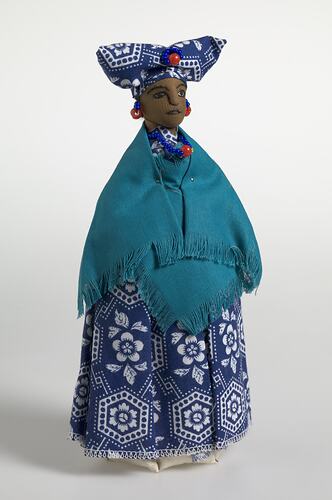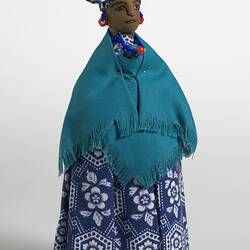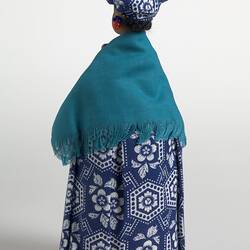Summary
National Doll produced to represent a Herero women from Namibia. Dolls are among the most universal toys found throughout the world and through history. Ornamental dolls can also be used to represent aspects of cultural traditions, such as dress.
The Herero belong to the Bantu group, the majority live in Namibia, with the remainder living in Botswana and Angola. Herero women adopted the Victorian fashions of the 19th Century Germans who colonised their lands. During the 17th and 18th centuries the Herero migrated to Namibia. Then in the 19th Century German colonists began to arrive and settle the land, creating the colony, German South-West Africa.
Conflicts soon arose between the German colonists and the Herero controversies frequently arose due to disputes about access to land and water, and discrimination against the native population. This led to the Herero Wars in 1904 when the Herero and Nama (another group living in Namibia), rose up against the German colonists. After some early success the German Empire sent a military expedition corps under the command of Lothar von Trotha, who waged war against the Herero and Nama and embarked on a genocide of the two groups. The result was the death of between 25,000 and 100,000 Herero, about 10,000 Nama and 1,749 Germans, It is thought that three quarters of the Herero population were killed during this conflict.
This doll comes from a collection of approximately 150 dolls in an array of national and regional costumes which were collected by Edna Setford from 1964-1988. Her husband Clifford continued the collection until his death in 1997. The collection is the work of both Edna and Clifford as well as many friends and family who brought dolls home to Edna as gifts from overseas trips. The final doll arrived two days after Clifford's death.
These dolls were purchased as souvenirs of particular countries and like many mass produced souvenirs they are often not accurate representations of a particular country or region, and may actually better reflect neighbouring counties or regions. This occurs because costumes are often stylised and simplified resulting dolls wearing generic costume elements which are common to many countries/regions. Often the fabrics and decorations used are selected to make the dolls cheap and easy to manufacture and aesthetically pleasing. This can result in the fabrics, colours and decorations of the doll's clothing having little or no reflection of the costume associated with a particular country or region they are meant to be representative of.
Physical Description
Female brown fabric doll dressed in blue and white patterned dress, with a turquoise shawl, blue and white headdress. The doll also wears a necklace of blue and red beads and matching earrings.
More Information
-
Collecting Areas
-
Acquisition Information
Donation from Eril Wangerek, 01 Sep 1997
-
User
Mr & Mrs Edna & Clifford Setford, Victoria, Australia, circa 1964-1997
Owners of this doll collection which was acquired during this period. -
Place Depicted
Namibia
This doll is intended to represent aHerero woman from Namibia -
Classification
-
Category
-
Discipline
-
Type of item
-
Dimensions
155 mm (Width), 265 mm (Height)
-
Keywords
Africa, Keepsakes, National Costumes, Souvenirs, Travel, Women's Clothing



